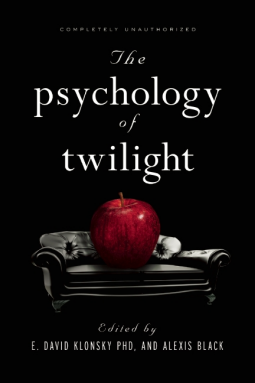The Psychology of Twilight Edited by E. David Klonsky, PhD, and Alexis BlackI love pop science books. I snap up BenBella and other publishers' books, whether they examine the science, philosophy or psychology--even if I've never watched the show. Sometimes I read the books, which intrigues me to watch the show. This happened when I read Caitlin Flanagan's article in Atlantic Monthly. Plus, my curiosity piqued when students wrote "I [heart] Jacob" or "I [heart] Edward" on their notebooks.
BenBella Books, Inc.
Anti-Twilight sentiment is prevalent due to anti-girliness (usually among adolescent boys) or to anti-anti-feminists who see the series as setting back the clocks. Ashley Fetters smartly addresses the scenario (again in Atlantic Monthly): different strokes for different folks."
The Psychology of Twilight also addresses these criticisms, and because they possess doctoral degrees in psychology, they do so, backing up their ideas with evidence, which is more interesting than popular reductionist theories which do not fully account for a book series. The only way to critique the books is from the inside: understanding them, then addressing shortcomings. Antagonists tend to oversimplify.
On the other hand, that The Psychology of Twilight exists, may give the opposite false impression: that Meyers wrote these books to present a treatise on adolescent psychology, but the authors almost never treat the book in this manner (occasionally, they take the series a little too seriously, but I suspect it's tongue-in-cheek or fan-girl geekiness shining through: "Team Edward!" "Team Jacob!").
Here are the topics discussed:
- "Bella and the Psychobiology of Love and Attraction" by David A. Frederick, et al. discusses the evolutionary causes of Bella's behavior and attraction to
- "Team Jacob" by Erica Berg discusses what advantages Jacob has a love candidate.
- In "The Case for Edward Cullen" Susan Carnell tackles what Edward's psychological draw is.
- "Prejudice" by Melissa Burkley examines human tendency to pre-judge and Twilight sometimes falls prey yet other times plays off our prejudice and others thwarts such expectations.
- Similarly, Amanda M. Vicary and Jennifer L Rosner take the prejudice and show us different groups can get along in "Vampires and Werewolves Aren't So Different After All."
- Mikhail Lyubansky discusses the shades of gray of Twilight in "The Gestalt of Twilight." The unified whole cannot be understood by examining the parts. Lyubansky says that Meyers understands that we create false dichotomies instead addressing full complexities. Two sides may be equally correct.
- Robin S. Rosenberg maps the vampiric urge to eat human blood on to our urge to eat unhealthily and suggests better methods in "Vegetarian Vamps."
- Jeremy Clyman argues in "Self-Regulation: The Secret to Success in Twilight" that Edward Cullen is most attractive value is his ability to self-regulate, to withhold himself when he most wants to love or to kill.
- "Motorcycle, and Strangers, and Cliff Diving! Oh, My!" by Catherine R. Glenn was one of the more surprising of the articles, wherein she argues that Bella's risk-taking may actually be saving her life.
- "It's All in the Family" by Lisa M. Dinella and Gary W. Lewandowski Jr., another surprising article, compares Bella's and Edward's family. Edward's family of vampires wins out. Bella is a parentified child while Edward's is a balanced hierarchy without becoming enmeshed. This one occasionally loses sight of its target audience.
- Tamara McClintock Greenberg's "Transcendence and Twilight" shows why immortality may be a draw for Bella. Despite Meyer's often mentioned Mormonism, her characters do not have religion although some long for one.
- In "The Emotional Pleasures of Reading Twilight," Peter G. Stromberg examines what is the romantic pull of such books? The millions of copies sold testify to how it speaks to people's dreams and hopes. Stories create feelings inside readers, especially in terms of the conclusion where the lovers finally meet.
- Pamela Rutledge closes with "Twilight Convergence," discussing how readers have helped grow the Twilight series into a social phenomenon through new social media. Meyer discussed and interacted with her fans, and fans didn't have to share age or race in order to feel connections.
While all are informative, the first nine articles are especially enlightening. I feel smarter.


No comments:
Post a Comment